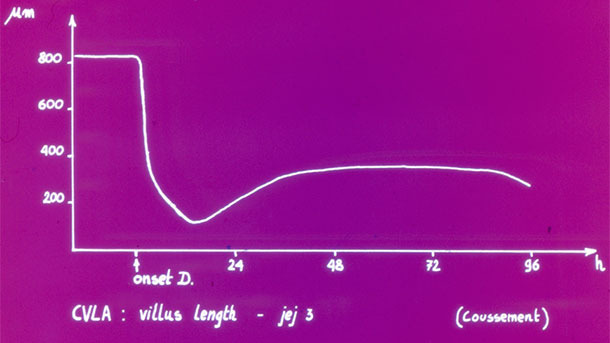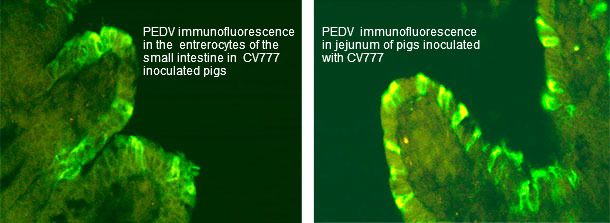Discussions have been held on the increase of virulence of US PEDV variants compared to strains from other continents, including Asian ones. Looking at the numerous early pathogenesis studies with CV777 in baby pigs in the late seventies, there is no reason to suggest a different pathogenetic pattern. CV777 infected all enterocytes on the small intestinal villi within 2 days after inoculation and caused rapid cell desquamation leading to severe villous atropy (reduction from 800 µm to 150 µm at 36 hours post inoculation), watery diarhea followed by rapid dehydration and nearly 100% mortality. Enterocytes on colonic villi were found to be infected but lesions in the colon were not observed and the colonic infection did not seem to play a role in the diarrheal process. The tropism of this virus was limited to the intestinal enterocytes and no other sites of replication were found in the body. These findings are not different from those described with US variants claimed to be more virulent. On this basis, virulence of some variants described in the US is not increased compared to that of CV777. Comparative pathogenesis studies with both the US and the CV777 European PEDV would be useful but it should be taken into account that, for such studies, the pig adapted CV777 has to be used as inoculum. Since the CV777 has been adapted to cell cultures, it may have undergone an unknown and uncontrolled number of passages and coronaviruses are known to rather easily undergo genetic alterations through serial passages in cell cultures.


Indeed, pig mortality rates in some US outbreaks of PED are high and may seem higher than in Europe. However, it is difficult to compare the PED impact between countries, since the impact is determined by many factors other than the pathogenicity of the virus, such as the production system, the time of detection of an outbreak, farm management, herd size, measures taken etc…The final loss expressed as number of dead baby pigs is thus of multifactorial nature and, undoubtedly, the intensification of pig farming is contributing to the possibly increased losses now claimed to occur in US PED outbreaks. Pig farming methods and herd sizes nowadays are hardly comparable to the situation in the seventies. Even in the seventies in Europe and in naive populations, the severity of disease and rate of pig losses associated with PEDV outbreaks varied between herds. Moreover, as there were no PEDV antibody detection assays available in the mid seventies, it was impossible to assess a possible protective effect of immunity that may have been induced against CV777-like strains by the earlier circulation of the relatively mild “TOO” virus strain. But it is clear that, when solely considering the interaction between the virus and the individual animal, virulence of the so-called “highly virulent US PED variants” is not different from the pig adapted CV777 isolate and reference strain.

Recently, PED outbreaks in Europe caused by PED viruses with high sequence identity to US PEDV but with rather low impact have recently been reported in Italy, Belgium, the Netherlands and Germany. Several of these outbreaks have occurred in fattening farms and are characterised by severe diarrhea but without deaths. Apparently, they have not been the cause of an epidemic of PED on breeding farms, though the breeding population was and is largely immunologically naive for PEDV in most European countries. The possibility should be considered that, certainly in Europe, early PEDV strains (TOO like) as observed in outbreaks in the early seventies in which baby pigs were not involved, may still be circulating. Literature in Europe shows that PED outbreaks rarely have occurred in the last decades and thus before PED recently obtained renewed attention. The rather innocent and rapid course of the PED disease caused by such strains may not have led to a diagnosis as the disease is transient and losses are minimal. Pathogenicity studies with such strains in baby pigs may be very useful to clarify to what extent these strains replicate in the intestines of baby pigs as genome analysis only will not give the answer. This might give a better insight in the epidemiology of PED in Europe.



